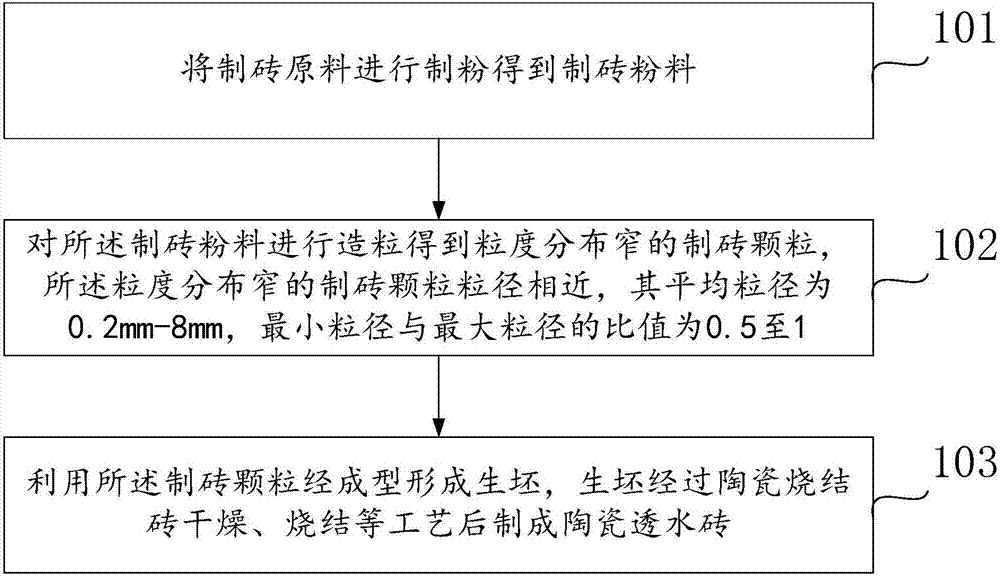Method for preparing ceramic water permeable brick by virtue of granulation process
A permeable brick and granulation technology, applied in ceramic products, manufacturing tools, ceramic molding machines, etc., can solve problems such as difficulty in absorbing stagnant water, increasing surface runoff, and going deep into the ground, achieving broad application prospects, controllable quality, Significant economical effect
- Summary
- Abstract
- Description
- Claims
- Application Information
AI Technical Summary
Problems solved by technology
Method used
Image
Examples
preparation example Construction
[0035] Such as figure 1 As shown, an embodiment of the present invention adopts a method for preparing ceramic permeable bricks using a granulation process, and the method for preparing ceramic permeable bricks using a granulation process includes:
[0036] Step 101: Powder the brick-making raw materials to obtain brick-making powder.
[0037] Among them, the brick-making raw materials include: clay, clay, clay, red mud, boron mud, steel slag, nickel slag, copper slag, fly ash, high silica rock, tailings, tailings, refining slag, water quenching slag, waste ceramics At least two kinds of bricks, waste sintered bricks and tiles, coal gangue, blast furnace slag, ferroalloy slag, and metallurgical dust.
[0038] Step 102: Granulating the brick-making powder to obtain brick-making particles with a narrow particle size distribution. The particle size of the brick-making particles with a narrow particle size distribution is similar, and the average particle size is 0.2mm-8mm. The ...
Embodiment 1
[0064] Ingredients are formulated according to the performance requirements of the formula. The mass percentage ratio of each component is: steel slag 10%, clay 1 90%, and the particles are directly sieved to form particles with similar particle sizes. The particle size is 2.0-2.8mm, the smallest particle size The ratio of diameter to maximum particle diameter is 0.71. Then put these particles with similar particle size into the mold, further molding, drying and sintering. The molding pressure is 0.5MPa, and the sintering temperature is 1120°C. After firing, the measured compressive strength of the permeable brick is 46.2MPa, and the flexural strength is 8.3MPa. The water permeability coefficient is greater than 0.092cm / s.
Embodiment 2
[0066] Ingredients are formulated according to the performance requirements of the formula. The mass percentage ratio of each component is: red mud 10%, clay 2 90%, ball milling and crushing to form powder, and further granulation. During the granulation process, the powder and mass fraction are 1%. Mix ceramic additives to form granulated particles with similar particle size, the particle size is 1.65-2.79mm, and the ratio of the smallest particle size to the largest particle size is 0.59; then these particles with similar particle size are put into the mold for further molding , drying and sintering, the molding pressure is 0.5MPa, and the sintering temperature is 1110°C; the compressive strength of the permeable brick measured after firing is 48.2MPa, the flexural strength is 8.5MPa, and the water permeability coefficient is greater than 0.061cm / s.
PUM
| Property | Measurement | Unit |
|---|---|---|
| The average particle size | aaaaa | aaaaa |
| The average particle size | aaaaa | aaaaa |
| Compressive strength | aaaaa | aaaaa |
Abstract
Description
Claims
Application Information
 Login to View More
Login to View More - R&D
- Intellectual Property
- Life Sciences
- Materials
- Tech Scout
- Unparalleled Data Quality
- Higher Quality Content
- 60% Fewer Hallucinations
Browse by: Latest US Patents, China's latest patents, Technical Efficacy Thesaurus, Application Domain, Technology Topic, Popular Technical Reports.
© 2025 PatSnap. All rights reserved.Legal|Privacy policy|Modern Slavery Act Transparency Statement|Sitemap|About US| Contact US: help@patsnap.com

